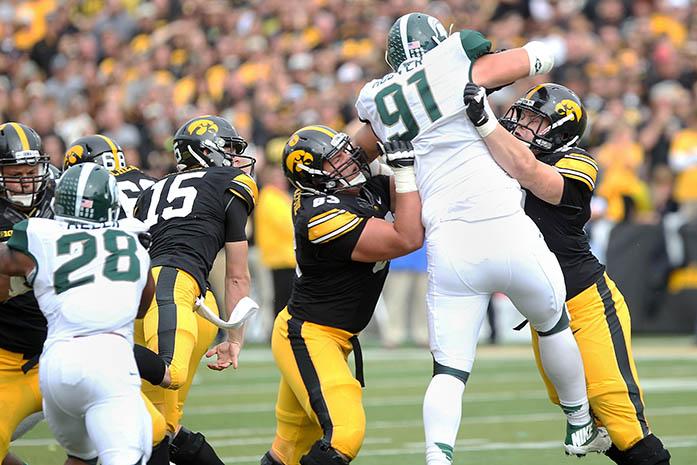By the Numbers: Iowa-North Texas
Iowa rushing defense: 51 yards per game, North Texas rushing offense: 143.5 yards per game
Although the Hawkeyes haven’t exactly faced powerhouses in Illinois State, Iowa State, or James Conner-less Pittsburgh, their run defense has been nothing short of stout this season.
Give credit to defensive coordinator Phil Parker’s entire front, but also to Iowa’s defensive backs. As you read (or should read) in this week’s cover story, Desmond King and Greg Mabin have done a fantastic job funneling ball carriers inside where there is help. Safeties Jordan Lomax and Miles Taylor have done a good job as well.
It’s tough to tell what North Texas will do, as it has played only two games this season.
But in the early-going, it has been more pass-heavy (more in a moment). In fact, with an average of only 30 rushes per game, they own the penultimate spot in Conference USA in that category. Western Kentucky is last, averaging 27.67 rushes per contest.
Senior running back Antionne Jimmerson leads the Mean Green with 134 yards and a touchdown on 22 carries.
In theory, this will be a tune-up for Parker and company, as things will get tougher once the Big Ten season starts, but it’s so far, so good for the Hawkeyes.
North Texas sacks allowed per game — 2
Something Iowa’s been missing this season is a consistent pass rush. Against Illinois State and Iowa State, the Hawkeyes totaled nine sacks. However, with the absence of an effective Drew Ott against Pittsburgh, Iowa garnered only two sacks — both of which came from defensive end Nate Meier, who plays opposite Ott.
North Texas has done a good job of protecting City High graduate Andrew McNulty, who is averaging 215.5 passing yards per game on 34.5 attempts.
Senior linebacker Cole Fisher compared North Texas’ offense to Iowa State’s (which threw 35 times against the Hawkeyes), meaning the pass rush will be especially important this week.
Where or who the pressure comes from does not matter, but should Iowa sustain pressure on the not-so-mobile McNulty and North Texas’ pass-first offense, the Mean Green could be in for a very long afternoon in Kinnick Stadium.
Time of possession per game: Iowa, 32:51. North Texas, 21:10
In the early going, Iowa’s been best when it has sustained, controlled scoring drives. Of the Hawkeyes’ 15 scoring drives this year, seven have lasted more than five minutes.
The only five-plus-minute drive on which the Hawkeyes haven’t scored this year came against Iowa State, when running back Jordan Canzeri fumbled in the red zone.
Dictating the pace of play early in the game can be crippling to a lesser opponent (see: Illinois State). It would be beneficial to the Hawkeyes to end the game on the first few drives, just like against the Redbirds.
If the statistics hold true, the Hawkeyes shouldn’t have much trouble putting the ball in the offense’s hands against the Mean Green.
North Texas total defense: 503 yards per game
That is not a typo. The Mean Green have been that bad through two games. That number ranks 117th among FBS schools.
Of course, this is an enormous advantage for the Hawkeyes, who rank third in the Big Ten in total offense at 423 yards per game. Assuming the Hawkeyes don’t totally lay an egg, there’s no reason to think they could move into the top two in the conference.
Now, the Hawks aren’t exactly playing elite defenses, so that number isn’t the Alpha and the Omega. But the only thing you can do if you’re the Hawkeyes is play well against the teams on your schedule, and that should be the case against an extremely lowly defense.



